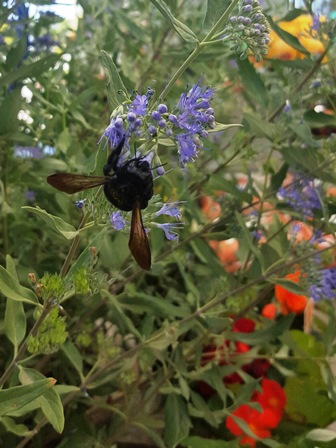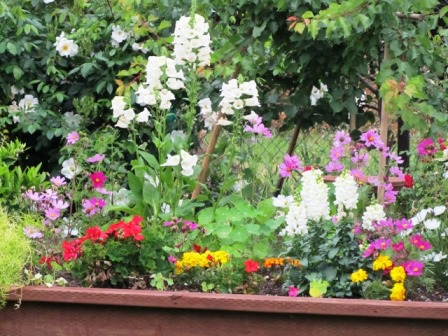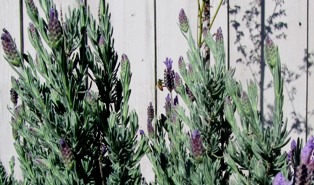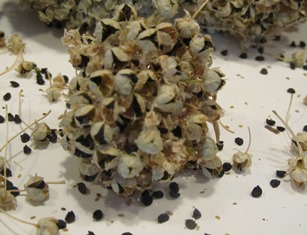How to Attract Local Pollinators
Today, I spotted a gorgeous bee, big and black with reddish-brown wings, dipping its proboscis into the lavender wisteria and other blooms in my garden. I was stung by a bee yesterday, but that doesn’t stop me from smiling with delight observing this little pollinator at work in my garden.

This longhorn bee, twice the size of a honeybee, dips its proboscis (meaning, tongue, nozzle, or snoot) into a bloom.
I admit I’m a fan of pollinators and enjoy watching them work amid the sunflowers, zinnias, cosmos, wisteria, and other blooms in the bee and butterfly garden I planted earlier this year.
The flowers attract hummingbirds, butterflies, bumblebees, and other types of bees, including my own Italian honeybees, the stock of bees most favored in this country (Apis mellifera ligustica). See, http://beesource.com/resources/usda/the-different-types-of-honey-bees/
Honeybees pollinate 90 percent of North America’s commercially produced crops, including almonds. That’s why many Northern California almond growers rent honeybees for use in their orchards during springtime bloom.
The National Academy of Sciences has noted that pollinators are needed to reproduce 75 percent of the Earth’s flowering plants. But there’s been a drop in natural pollinators, in part due to habitat loss and pesticide use.
Populations of the yellow, black, and brown Western bumblebee, once common from southern British Columbia to central California, have now all but disappeared. To attract bumblebees, plant giant hyssop, milk weed, and nettle-leaf horse mint. See, http://www.wildflower.org/collections/collection.php?collection=xerces_bumble
Here’s what else we gardeners and farmers can do to attract local pollinators.
1. Avoid using pesticides.
2. Plant bee, bird, and butterfly friendly native plants.
3. Choose plants that flower in varying diverse colors and shapes to attract a wide variety of pollinators.
* * *
If you enjoy reading about farmette topics (including gardening, beekeeping, and delicious recipes), check out my cozy mysteries A BEELINE TO MURDER and also THE MURDER OF A QUEEN BEE in the Henny Penny Farmette series (from Kensington Publishing).
These novels are available through online retailers such as Amazon, Barnes & Noble, Kobo Books, and Walmart as well as from traditional bookstores everywhere.
See, http://tinyurl.com/hxy3s8q
Now available in mass market paperback, this debut novel launched the Henny Penny Farmette series of mysteries and sold out its first press run.
See, http://tinyurl.com/h4kou4g
The second cozy mystery in the Henny Penny Farmette series, available Sept. 27, 2016
Gathering Seed for Next Year’s Garden
The sounds of summer around our farmette have grown quieter. It’s mid-August and the neighborhood children have returned to school. I miss their laughter. I miss the delight on their faces at seeing the chickens and the honeybees. I miss keeping them company at their lemonade stand.
But I admit to the secret pleasure of solitude and quiet, though it isn’t really silence. It’s the peaceful clucking of chickens and the twitter of songbirds as I gather seed from plants that have bloomed and dried, such as the cosmos, nasturtiums, sunflowers, and wisteria.
The wisteria vine that exploded in growth of long, green tendrils during spring and early summer and graced us with bracts of purple perfusion now hold heavy pods. The pods contain seeds that can be dried and planted for new vines next year.
The sword-shaped leaves of the irises are dry–their blooms a memory from early spring. I’ve already cut their long leaves back into four-inch fans and will dig some of the rhizomes for replanting in other beds around the farmette.
The sunflowers that the bees love to forage on have gone to seed. Those seeds will become next year’s plants, but some we’ll save for the squirrels.
The red and yellow onions have developed seed pods on long shoots now. I’ll plant those in raised beds in the fall for a spring crop of onions.
Yes, the dog days of summer have come around again. But the growing season continues. End of summer gives rise to autumn when grapes, persimmons, pumpkins, figs, and pomegranates ripen. On the farmette, there is always another season and other crops to look forward to with anticipation. It’s the good life.
 Facebook
Facebook Goodreads
Goodreads LinkedIn
LinkedIn Meera Lester
Meera Lester Twitter
Twitter












